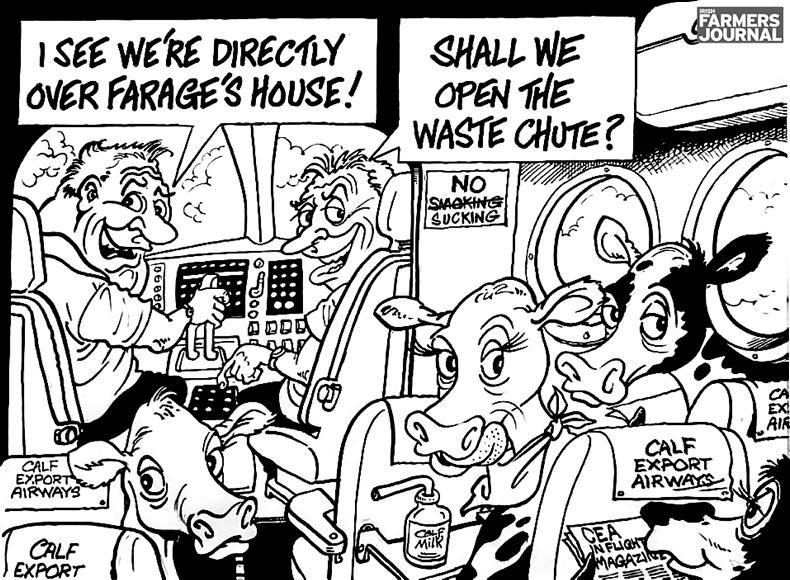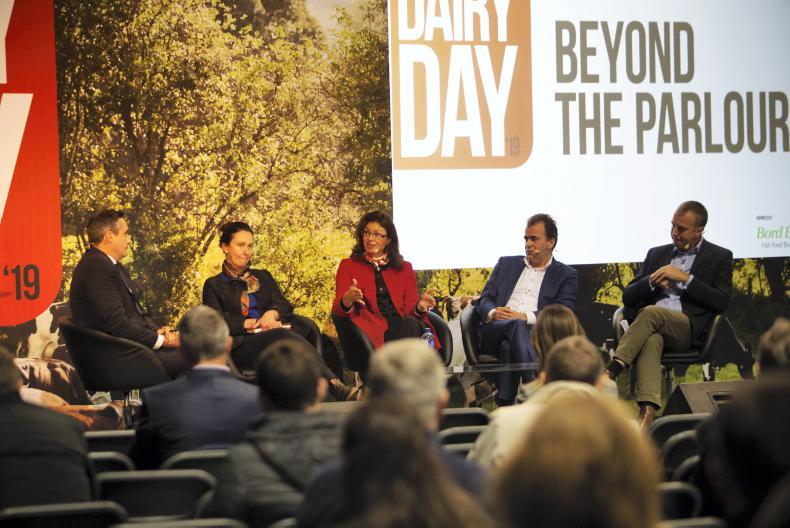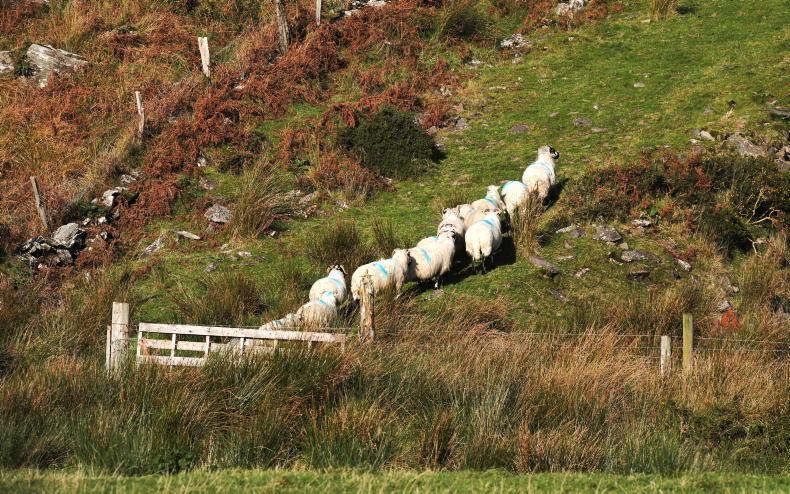With the value of exports less than 4% of the combined value of beef and dairy, the sheep sector is often overlooked when discussing the future of agriculture. However, given the largely silent revolution that has taken place in recent years, it is a sector that has the potential to make a very valuable contribution to the future of Irish farming.
We recently had the opportunity to review the performance of the flock on our demonstration farm in Tullamore. A docket for lambs slaughtered last week showed an average sale value of €118. Selling 1.7 lambs per ewe at an average price of €110 per lamb and equating one ewe to 0.15 livestock units (LU) generates an output of over €1,250 per LU. Earlier in the year, 15-month-old bulls sold off the farm averaged €1,380. These animals were on the farm for twice as long, required additional housing facilities and consumed almost 1.6 tonnes of concentrate.
The €14.7m injection delivered through the Sheep Welfare Scheme, which was hard-fought for by IFA and other farm organisations, plus the fact that the sector is enjoying strong market prices, running 80c/kg ahead of last year, is obviously helping to boost financial performance. But there is more at play. In a lowland context, we have seen a significant change in market focus with the percentage of lambs now sold in carcase form falling from 70% to just 25%. This has seen the focus shift from the French wholesale market to higher value EU markets, with particular success in Germany and Belgium.
Ireland ideally positioned
The outlook remains positive. Ireland is ideally positioned to take advantage of a market situation where New Zealand sheepmeat imports into the EU, which is just 94% self-sufficient, are falling. The sector is also eagerly awaiting access to the lucrative US and Chinese markets. In the context of Brexit, it is one of the few sectors within farming that could see a positive dividend with lamb from Britain locked out of the EU.
Meanwhile, we have seen a similar level of innovation within the hill sheep sector. The collapse of the Mediterranean market for light hill lambs was not taken lying down. Instead, the industry, led by farmers and supported by Teagasc, came together to look at alternative outlets and develop new feeding strategies to meet demand.
For a number of years now we have seen the INHFA coordinate what has been a very successful hill lamb campaign led by Bord Bia and supported by the Kepak Group, while other processors are successfully working with farmer producer groups and servicing appetite for light lamb in Scandinavian markets.
On the back of their success, Kepak has created an Atlantic hill lamb brand. The increased market demand has seen prices for light 18-25kg liveweight lambs lift from €20 to €30 to closer to €50. Finished hill lambs that were typically selling for €1/kg less than the French price are now on par with what is being returned in the French market.
The same level of innovation and market focus is evident with ewe lambs. The hill ewe has become the foundation stone of many lowland flocks. Lowland sheep farmers flock to special annual breeding sales paying premium prices for top-quality replacements.
While falling short of the income-generating capacity of dairying, the production of sheepmeat does have the potential to deliver a viable alternative for farmers operating on marginal and/or fragmented land. While often cited for having an increased workload, the ability to target labour at specific periods in the year lends itself to part-time operations. The availability of well-designed and constructed mobile handling and dipping facilities has greatly reduced the level of manual labour.
From an environmental perspective, the sheep sector plays a vital role in the management of marginal grassland / hill vegetation and the ability of these soils to retain and sequester carbon.
In this sense, it could be argued that it is the sheep sector that comes closest to representing the true definition of sustainability, ticking the environmental and economic box.
Far from ignoring the sector, we should look to the valuable lessons of what can be achieved by matching production and breeding regimes to market demands and environmental conditions.
Is it time for a national plan to further develop and grow this sustainable sector?

\ Jim Cogan
Dairy: amended milk price review and Dairy Day

We won't have a crowd at Dairy Day this year but the agenda is packed nonetheless.
KPMG reported a small error to us in the computation of the annual Irish Farmers Journal/KPMG milk price review published last week. Given the importance of the exercise and in the interests of transparency and fairness, we have decided to republish the prices in full this week with the amended Drinagh Co-op price and the associated comparisons with other processors.
Next week we will resume a broader piece of analysis and comparison to drive further positive change in this sector and hopefully help dairy farmers better understand what’s important. We have also rescheduled our planned webinar to allow for further interaction on the exercise for Friday 27 November.
Sometimes when milk price comparisons are made we forget that the predominantly co-op structure has invested significantly in milk processing to allow farmers to grow family businesses. In previous years, we have gathered representatives from north and south to Punchestown for our annual Dairy Day discussion and showcase, but unfortunately that’s not possible this year.
Instead, next Tuesday 24 November we will hold VIRTUAL Dairy Day. Our dairy team will deliver three 30-minute sessions, at 11am, 1pm and 8pm. These are free to watch at www.ifj.ie/dairyday and no registration is necessary. The team will also be on hand after each session to answer questions. Similar to previous Dairy Days, the content varies from inside the farm gate challenges like grassland management and livestock handling to outside the farm gate challenges such as the journey of butter from Cork to Chicago and investing in peak milk processing.
See www.ifj.ie/dairyday for more.
Tillage: another tough year in the fields

\ Donal O' leary
The recent Teagasc harvest report summarises the impact that the poor 2020 growing season has had on tillage farmers.
A 20% reduction in overall grain production (1.9m tonnes) and a 30% reduction in straw output summarised the consequences of the altered planting patterns and subsequent drought.
Winter crop areas were down around 40% and some of this yielded very poorly to give a net 50% reduction in winter grain output.
Spring cereal areas increased to compensate but yields in most areas were also affected by the drought.
The importance of having a good spread of crops was emphasised by the good yield and price performance of winter oilseed rape.
Oats fared relatively well overall and spring barley bounced back from a potential drought-driven disaster to have a reasonable year in many but not all areas – except for the high rejection rates for malting with the loss of the price premium.
These factors combined meant that tillage incomes were badly hit by the year. While grain prices were up somewhat, they will not fill the gap in yields, which were very severe for growers in the worst weather-affected areas.
Beef Finisher Scheme a welcome relief
After a difficult year, the €46.6m paid out to beef farmers this week under the Beef Finisher Scheme will be welcome. The Department of Agriculture deserves credit for getting this money out to farmers quickly. The scheme helped put a floor under the weanling and store trade this autumn. It had an initial budget of €50m. The €3.4m under-spend should be used to fund force majeure cases, particularly in the case of farmers who sold cattle for direct slaughter to Northern Ireland.
Read more
Preparing for sheep inspections: the important aspects to consider
Sheep management: Drafting lambs, ram lamb management and CLP issues
With the value of exports less than 4% of the combined value of beef and dairy, the sheep sector is often overlooked when discussing the future of agriculture. However, given the largely silent revolution that has taken place in recent years, it is a sector that has the potential to make a very valuable contribution to the future of Irish farming.
We recently had the opportunity to review the performance of the flock on our demonstration farm in Tullamore. A docket for lambs slaughtered last week showed an average sale value of €118. Selling 1.7 lambs per ewe at an average price of €110 per lamb and equating one ewe to 0.15 livestock units (LU) generates an output of over €1,250 per LU. Earlier in the year, 15-month-old bulls sold off the farm averaged €1,380. These animals were on the farm for twice as long, required additional housing facilities and consumed almost 1.6 tonnes of concentrate.
The €14.7m injection delivered through the Sheep Welfare Scheme, which was hard-fought for by IFA and other farm organisations, plus the fact that the sector is enjoying strong market prices, running 80c/kg ahead of last year, is obviously helping to boost financial performance. But there is more at play. In a lowland context, we have seen a significant change in market focus with the percentage of lambs now sold in carcase form falling from 70% to just 25%. This has seen the focus shift from the French wholesale market to higher value EU markets, with particular success in Germany and Belgium.
Ireland ideally positioned
The outlook remains positive. Ireland is ideally positioned to take advantage of a market situation where New Zealand sheepmeat imports into the EU, which is just 94% self-sufficient, are falling. The sector is also eagerly awaiting access to the lucrative US and Chinese markets. In the context of Brexit, it is one of the few sectors within farming that could see a positive dividend with lamb from Britain locked out of the EU.
Meanwhile, we have seen a similar level of innovation within the hill sheep sector. The collapse of the Mediterranean market for light hill lambs was not taken lying down. Instead, the industry, led by farmers and supported by Teagasc, came together to look at alternative outlets and develop new feeding strategies to meet demand.
For a number of years now we have seen the INHFA coordinate what has been a very successful hill lamb campaign led by Bord Bia and supported by the Kepak Group, while other processors are successfully working with farmer producer groups and servicing appetite for light lamb in Scandinavian markets.
On the back of their success, Kepak has created an Atlantic hill lamb brand. The increased market demand has seen prices for light 18-25kg liveweight lambs lift from €20 to €30 to closer to €50. Finished hill lambs that were typically selling for €1/kg less than the French price are now on par with what is being returned in the French market.
The same level of innovation and market focus is evident with ewe lambs. The hill ewe has become the foundation stone of many lowland flocks. Lowland sheep farmers flock to special annual breeding sales paying premium prices for top-quality replacements.
While falling short of the income-generating capacity of dairying, the production of sheepmeat does have the potential to deliver a viable alternative for farmers operating on marginal and/or fragmented land. While often cited for having an increased workload, the ability to target labour at specific periods in the year lends itself to part-time operations. The availability of well-designed and constructed mobile handling and dipping facilities has greatly reduced the level of manual labour.
From an environmental perspective, the sheep sector plays a vital role in the management of marginal grassland / hill vegetation and the ability of these soils to retain and sequester carbon.
In this sense, it could be argued that it is the sheep sector that comes closest to representing the true definition of sustainability, ticking the environmental and economic box.
Far from ignoring the sector, we should look to the valuable lessons of what can be achieved by matching production and breeding regimes to market demands and environmental conditions.
Is it time for a national plan to further develop and grow this sustainable sector?

\ Jim Cogan
Dairy: amended milk price review and Dairy Day

We won't have a crowd at Dairy Day this year but the agenda is packed nonetheless.
KPMG reported a small error to us in the computation of the annual Irish Farmers Journal/KPMG milk price review published last week. Given the importance of the exercise and in the interests of transparency and fairness, we have decided to republish the prices in full this week with the amended Drinagh Co-op price and the associated comparisons with other processors.
Next week we will resume a broader piece of analysis and comparison to drive further positive change in this sector and hopefully help dairy farmers better understand what’s important. We have also rescheduled our planned webinar to allow for further interaction on the exercise for Friday 27 November.
Sometimes when milk price comparisons are made we forget that the predominantly co-op structure has invested significantly in milk processing to allow farmers to grow family businesses. In previous years, we have gathered representatives from north and south to Punchestown for our annual Dairy Day discussion and showcase, but unfortunately that’s not possible this year.
Instead, next Tuesday 24 November we will hold VIRTUAL Dairy Day. Our dairy team will deliver three 30-minute sessions, at 11am, 1pm and 8pm. These are free to watch at www.ifj.ie/dairyday and no registration is necessary. The team will also be on hand after each session to answer questions. Similar to previous Dairy Days, the content varies from inside the farm gate challenges like grassland management and livestock handling to outside the farm gate challenges such as the journey of butter from Cork to Chicago and investing in peak milk processing.
See www.ifj.ie/dairyday for more.
Tillage: another tough year in the fields

\ Donal O' leary
The recent Teagasc harvest report summarises the impact that the poor 2020 growing season has had on tillage farmers.
A 20% reduction in overall grain production (1.9m tonnes) and a 30% reduction in straw output summarised the consequences of the altered planting patterns and subsequent drought.
Winter crop areas were down around 40% and some of this yielded very poorly to give a net 50% reduction in winter grain output.
Spring cereal areas increased to compensate but yields in most areas were also affected by the drought.
The importance of having a good spread of crops was emphasised by the good yield and price performance of winter oilseed rape.
Oats fared relatively well overall and spring barley bounced back from a potential drought-driven disaster to have a reasonable year in many but not all areas – except for the high rejection rates for malting with the loss of the price premium.
These factors combined meant that tillage incomes were badly hit by the year. While grain prices were up somewhat, they will not fill the gap in yields, which were very severe for growers in the worst weather-affected areas.
Beef Finisher Scheme a welcome relief
After a difficult year, the €46.6m paid out to beef farmers this week under the Beef Finisher Scheme will be welcome. The Department of Agriculture deserves credit for getting this money out to farmers quickly. The scheme helped put a floor under the weanling and store trade this autumn. It had an initial budget of €50m. The €3.4m under-spend should be used to fund force majeure cases, particularly in the case of farmers who sold cattle for direct slaughter to Northern Ireland.
Read more
Preparing for sheep inspections: the important aspects to consider
Sheep management: Drafting lambs, ram lamb management and CLP issues









 This is a subscriber-only article
This is a subscriber-only article










SHARING OPTIONS: